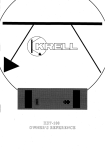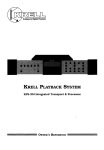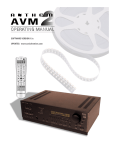Download Krell Industries KBL User's Manual
Transcript
KBL & KPA OWNERS’ MANUAL 45 ConnairRoad Orange,CT06477-0533, USA KBL & KPA OWNERS’ MANUAL INTRODUCTION Thank you for your purchase of a new KRELLpreamplifier. This Owners’ Manual covers both the KBL and KPA preamplifiers, as they have been designed to be companion pieces and can be utilized in varying combinations. For each user there will be information that does not pertain to their specific situation. Therefore, in the interest of clarity, details relating to different combinations are presented in well-defined sections. The KBL and KPA represent significant departures from traditional preamplifier design. The time invested in carefully reading this manual will yield an important understanding of the functions and design features of the units. Due to the high level of performance of which these units are capable, careful placement and installation are crucial. Your thorough understanding of the operations of the KBLand KPAwill help insure their maximum performance and long life. ABOUT THE OWNERS’ MANUAL The KBL/KPA Owner’s Manual is divided information. The purpose of the document as a with the units and guide you through their operation in a logical progression. The Table of A. Serial Number(s) and Factorv-Shi~ed B. General Information: a description features of the KBL and KPA C. Unpacking: detail of accessories various configurations into various groups of whole is to familiarize you set-up, installation and Contents is as follows: Confia~ration of the basic design and performance shipped with the KBL and KPA in D. Installation: 1. 2. 3. 4. 5. 6. 7. 8. Caution Connector Details Connector Termination Types Cable Requirements for Inputs and Outputs Setting of Internal Switches Unit Location Guidelines and Installation Connection of Inputs and Outputs Turn-on of the Preamplifiers E. Operation: 1. KPAFunctions 2. KBLFunctions F. ,W~rranty ~nd Service Information G. Termination A. SERIAL Drawings NUMBERS & FACTORY-SHIPPED KBL preamplifier serial factory set-up for operation. CONFIGURATION number was shipped from the stereo operation dual-mono Please refer to information specific to this modeof operation throughout the manual. Should you wish to change between stereo and monaural operation please refer to section D. 5. This is only necessary when changing either unit from stereo to monooperation. All KPAare shipped from the factory set-up for stereo operation. Please refer to section E. 1. d for information regarding dual-monooperation. B. GENERAL INFORMATION The KRELLKBL(Krell Balanced Line) and KPA(Krell Phono Amplifier) present many new concepts in preamplifier design. The traditional preamplifier contains both a phono section and a line section. The KBLand KPAdivide these functions into two separate units. This was done for several reasons. The primary motivation was to allow adequate space to accommodatethe latest evolutions of preamplifier circuitry and functions. 2 These units are the current state-of-the-art. No compromisewas allowed in their design. Details concerning their technical performance are covered in more detail below, A second important consideration was to introduce the programmable concept employed in our current KSA/KMA amplifier line into our preamplifier line. A single KBLand KPAare used for stereo operation. A second unit of either can be added to achieve dual-mono, fully balanced operation. They can be easily changed without being returned to the factory. There are many advantages to dual-mono operation. The capability of the KBLand KPAto operate in either modeallows you to plan the development of your system over time, without the waste of money and time associated with trading or selling used gear. It also allows you to optimize your system more closely to your needs. For example, if line sources are most important, you can purchase two KBLs’, with or without a KPA. If phono is most important you can purchase two KPA’s and one KBLcreating a completely balanced path for the phono signal. The ultimate configuration, of course, is two KBLand two KPA.This creates a completely dual-mono, balanced preamplifier system for all inputs and outputs. Other details concerning the functions of the units are covered below and in the Installation and Operation sections. The method used to switch a KBL or KPA from stereo to dual-mono operation is unique. For stereo operation each chassis has complete circuit paths for the left and right channels. When switched to dual-mono, balanced operation the left channel circuitry is assigned to the non-inverted path and the right channel circuitry is assigned to the inverted path. This changes the rear panel connector assignments on both the KBLand KPA. See the sections on Installation and Operation below for more details. The KBL and KPA use high-bias, pure Class A circuits throughout, including the power supplies and regulators. Circuits are DCcoupled, meaning there are no capacitors in the signal path. The power supply system and output circuits are extremely high-power when compared with conventional preamplifier designs. The output section of the KBL, for example, is really a small power amplifier, capable of swinging 60 volts peak-to-peak. This allows the KBLto maintain exceptional linearity under all conditions and drive virtually any length of cable without signal degradation. The external supply has two stages of regulation. Within each preamp chassis there are independent tracking regulators for each section of circuitry, separated channel-to-channel. The KPAhas completely passive RIAAequalization. Maximumdeviation from the standard is +/- .1 dB from 10Hz to 20KHz. All parts are 1% tolerance. 3 Both preamplifiers have innovative operational features. The KBLhas two balanced inputs and one set of balanced outputs in addition to four singleended inputs and one set of single-ended outputs. This allows one KBLto accommodatebalanced line sources and amplifiers, which Krell believes to be the standard for high-end audio gear. Therefore, it is only necessary to purchase a second KBLto achieve dual-mono, fully balanced operation. The KBLinput labeling is a departure from the norm as well. Instead of the conventional "phono, tuner, tape, aux, etc." we have labeled the inputs B-l, B-2, S-l, S-2, S-3, S-4. These refer to Balanced Input #1, Balanced Input #2, Single-ended Input #1, etc. Components in audio systems today are unpredictable. This input labeling allows KBLSelector can to be set-up or changed by each user to create the order he desires. The KBLhas front panel adjustments for output gain and absolute phase. The Gain switch provides a course adjustment to compensate for systems of different efficiencies and for level differences in source components. The KPAhas inputs for two different cartridges. There is a front panel switch to adjust between the gains required for moving coil and moving magnet cartridges. Adjustment for cartridge impedance loading is on the front panel as well. Perhaps the most interesting features on the KPAare the front panel adjustments for high and low RIAAtrim. These allow you to tailor the RIAAequalization to specific records in small increments. Single-ended/Balanced switching are also on the front panel. C. UNPACKING Remove the units from the shipping container. Keep the shipping materials in a safe, dry place for future use. The following is a list of the materials that are included in the packaging. 1 each: preamplifier chassis KBLpower supply with DCcable installed ACline cord "T" shaped Allen driver Spare fuse for the power supply Owner’s Manual 1 KBL~ 1 KPA~acked together I each: KBL& KPApreamplifier chassis KBLpower supply with DCcable installed ACline cord DCjumper cable (KBL to KPA) "T" shaped Allen driver Spare fuse for the power supply Owner’s Manual 4 1 KP~without _vower supvlv preamplifier chassis DCjumper cable (KBL to KPA) "T" shaped Allen driver Owner’s Manual 1 each: 1 KPA with~owersu~pl_v 1 each: preamplifier chassis KPApower supply with ACand DCcables attached DC jumper cable (KBLto KPA)*not used when the dedicated KPAsupply is used* "T" shaped Allen driver Owner’s Manual Inspect the unit(s) and power supply(s) for damage. If any is evident, or some of the accessories are missing, contact your dealer or the factory immediately. If everything is in order you can proceed with the next steps. D, IN/~TALLATION 1. Cautions Note: These are important points of which you should always be aware. They are presented before the actual installation procedures, should you not read through the Manual entirely. a. Wheninstalling the KBLalways connect the DC cable between the preamp chassis and the power supply before plugging the power supply into the ACmains. b. When installing a KBL/KPA combination ~ connect the DC cables between the KPAand the KBL, and between the power supply and the KBLbefore plugging the power supply into the ACmains. c. ~ disconnect the AC from the mains before DCcable(s) from the preamp(s). disconnecting the d. A single KPAcannot be operated in balanced mode. The "Balanced" push-button should not be activated unless two KPAare used. e. These points are true for both the initial installation of the KBLor KPAand for revisions of your system that require their relocation. 2. Connector Details This section, with sections 3 & 4 below, presents all details necessary to make or modify cables for use with all combinations of the KBLand KPA. After reading these sections, check all the cables you intend to use to make sure they are appropriate for your installation. a..Gener~:[ .. Information Different configurations of the KBLand KPArequire different cable terminations. The connector assignments for the KBLand KPAinputs and outputs are given. b. KBLConnector Assignments: c. KPA(~)nnector B-l, B-l: female 3-pin XLR S-l, S-2, S-3, S-4: female RCA Record Outputs : 2 sets, female RCA Main Outputs: 1 set on female RCA 1 set on 3-pin male XLR Assi~arnment: All are female RCA 3. Connector Termination _T~es For all terminations: ends of the cable. Make sure wire color and pin numbers match at both a. Standard RCATermination; uses either coaxial cable: coax cable or two-conductor Center pin = audio signal Outer ring = ground: when using two-conductor coax cable one center conductor is connected to the outer ring at both ends; the shield is connected to the outer ring at only one end. This end should be marked and used at the input end of the cable. For example, this end would go, to the amplifier when the cable is run from preamp to amp. Used for all RCAinputs and outputs on the KPAand the KBLwhen operated with single-ended components. Dta.ndar.d XL.I~ T¢rmination: uses two-conductor coa~al qable: Pin 1 = ground Pin 2 = non-inverted signal (also called 0 or + signal) Pin 3 = inverted signal (also called 180 or - signal) Used on inputs B-l, B-2 and Main Output of the KBLwhen used in either stereo or dual-re, no. All Krell Industries and Krell Digital products use this pin-out for inputs and outputs. c. Balanced RCATerminatiom uses two-conductor coaxial cable: See Drawing1 at the rear of the Manualfor details. 1 pr. of RCAconnectors are used on each end of the cable with this termination; 4 prs. total are used if this termination is used at both ends. Red RCACenter pin = first cable center conductor (0 ,or +) White RCACenter pin = second cable center conductor (180 or -) Outer Ring, both RCA = shield from around the two center conductors Used for inputs S-I, S-2, S-3, S-4, Record Outputs, and the Main output of the KBLwhen operated in dual-mono. Used for both inputs and the Main output of the KPAwhen used in dual-mono. Can be used between two KPAsand two KBLsoperating in dual-mono. d. Balanced RCAto XLRTermination; uses two-conductor coaxial cable See drawing 2 at the rear of the Manualfor details. 2 prs. RCAand I pr XLRconnectors are used on each pair of audio cables The XLRend uses the termination detailed in section b above; the RCAend uses the termination detailed in section c above. Pin 2 on the XLRis the non-inverted signal and is soldered to the red RCA;Pin 3 on the XLRis the inverted signal and is soldered to the white RCA. Can be used between two KPAand two KBLoperating in dual-mono. e. Balanc~ KPAInput Termination; uses two-conductor coaxial cable. See Drawing3 at the rear of the Manualfor details. 2 prs. of RCAconnectors are used for each cable; 4 prs. total. This is a special termination that allows for a balanced input from the cartridge to two KPAs.There is no other use for this termination. 4. Cable Requirements for Inputs and Outputs Read the portions of sections a and b below that pertain to your system for the specific cable terminations required. If you are adding to your system you may need to change some cable terminations to take full advantage of dual-mono, balanced operation. ao S_vstemConfi~urationfl~ermination s Unit(s) One KBL Inputs B-1 & B-2 S-l, S-2, S-3, S-4 One KPA 1 &2 Unit(s) Inputs Two KBL Outputs Record 1 & 2 Main on RCA Main on XLR male, b male, a male, a male, a female, b Main male, a Outputs *B-1 &B-2 S-1, S-2, S-3, S-4 Two KPA are operational C c c female, b in dual-mono; the right 1 &2 Two KPA Termina~0n~ male, b Record 1 & 2 Main on RCA *Main on XLR *Only the left connectors connectors are disabled. Terminations e Main c b. Specific KPAto KBLCable Requirements Unit(s) Terminations One KPAto one or two KBLs a both ends Two KPAsto one or two KBLs c both ends Two KPAsto one or two KBLs 5. Setting of Internal Switches d, w/male XLR(KBL end) Please read this section to determine if you have the need or desire to change the internal switches. a. KBLStereo~D~al-M0n0 ~witches These switches are used to change the KBLbetween stereo and mono operation. Their most commonuse is to change an existing KBLfrom stereo to dual-mono when installing a second KBLfor dual-mono. There is one double-toggle, two-position dip switch between the input connectors for B-1 (SW6) and for B-2 (SW7); there is a third near balanced output connectors (SW8). All three switches mu@tbe set the same. They are not to be set in any other combination. -Positions C2 & C4 depressed are for stereo operation. -Positions C1 & C3 depressed are for monooperation.* *In dual-mono operation only the lef~ XLReQnneqt0r~ are operational; the right connectors are disabled. All RCAconnectors remain operational, but with different functions. See section D3, Connector Terminations, below for details. b. KBLIndicator LEDswitch The Symmetry LEDs on the KBLcan be disabled. Their function is unrelated to stereo or monooperation. The switch located just forward of SW8in the right, rear of the unit, controls this function. Positions 1 & 2 depressed allow the LEDsto light. Both switches depressed to "Open" disable the LEDs. 6. Unit Location Guideline~ and Installation Before installation of your KBL/KPA(s)and power supply(s) we recommend that you follow these guidelines in choosing proper locations for the units. This will help insure a trouble-free installation and maximum performance of the preamps. All associated equipmentshould be turned off at this point. a. Preamplifier Location Guidelines 1. The KBLand KPAmeasure 19" wide, 13" deep, 2.5" high. 9 Four inches clearance should be allowed above the top of either the KBLor KPA. Only a small amount of clearance is needed on the sides. Four to six inches clearance should be allowed at the rear of either unit to provide for cables. 3. The units can be stacked. KPA(s) should be placed on the bottom with KBL(s)on top. KPA(s) are sensitive to induced hum from motors or power supplies. In general, they should be located at least one foot from other components (with the exception of the KBL). In particular, power supplies, tape recorders, and turntables should be more than a foot away from the KPA(s). b. Preamplifier Installation Place the preamplifier(s) in position. Checkthat all cable lengths are adequate at this point. c. Power Supply Location Guidelines 1. The KBLsupply measures 9.75" wide, 12" deep, 2.25" high The KPAsupply measures 7.25" wide, 7.75" deep, 2.5" high (Only KPAnot powered from a KBLhave a separated supply) 2. Six foot ACand DCcables are provided with the supply(s). Plan the respective position of the supply(s) and preamplifier(s) within these distances. Allow at least a small amount of cable to be excess, so neither cable is pulled tight. Contact the factory if the DC cable is too short. Any attempt to extend it jeopardizes the power supply and the preamp, and will void the unit’s warranty. 3. Although well shielded, the power supply(s) should not be placed close to hum-sensitive components such as turntables, phono preamps or tape recorders. 4. Allow ample air space around the supply(s) for heat dissipation. Five inches on top and two inches on each side is adequate. Two supplies should not be placed directly on top of each other. They should be placed side-to-side. 5. The KBLor KPAsupplies do not require that an ACVcircuit be dedicated for their use. They should be connected to a 15 or 20 amp circuit that is dedicated for the source components and the preamplifiers. Do not connect them to the mains with light-gauge (18 or higher) extension cords or multiple outlet adapters. extension cords, outlet strips and good quality surge protectors that are rated for 15 amps and grounded are acceptable. d. Power Supply Installation 1. 2. 3. 4. Place the power supply(s) in location. Connect the DCcable(s) from the supply(s)to the preamp(s) Plug the DCjumper between the KBL(s) and KPA(s). Donot plug the ACconnector(s) into the mains at this time. 7. Connection of Inputs and Outputs All source componentsand amplifiers should be off at this point. Whenconnecting balanced components to the KBLvia RCAconnectors be sure to maintain proper polarity of the non-inverted and inverted inputs. The non-inverted inputs are the Left connectors on the top row; the inverted inputs are the Right connectors on the bottom row. Also, if you are using two KBLin dual-mono, remember that the Left XLRsare operational and the Right XLRconnecters are disabled. a. Connection of Input Sources 1. Connection of the KPAInputs and Outputs Either input cartridge. can accommodate a moving magnet or moving coil Single KPA:connect the cartridge outputs to the KPAinputs 1 & 2 in the conventional manner. Dual KPA.balanced in~)ut wiring from the cartridge(s); connect the "high" (left = white, right = red) output from the cartridge to the left input connectors on the KPAs.Connect the "low" (left = blue, right green) to the right input connectors on the KPAs. Typically the top unit is used for the left channel and the bottom unit is used for the right channel. The output of the KPAis high-level input and can be sent to any input on the KBL(s). Connect the output of the KPA(s) to the inputs at this time. 2. Connection of KBLInl~ts The inputs of the KBLhave not been labeled with specific component namesso you can set up the Select switch pattern to your preference. B-1 and B-2 refer to Balanced inputs 1 & 2; S-l, S-2, S-3, S-4 refer to Single-ended inputs 1 through 4. Once you have decided which componentwill be assigned to which input, proceed with connecting the source componentsto the desired inputs. b. Connection of KBLRecord Outputs There are two Record outputs which receive the signal from the input chosen on the Select switch for sending to two tape recorders. The two outputs are wired in parallel and have no relation to any of the inputs. Makethe connections between the Record outputs and tape recorders at this time. c. Connection of the KBLMain Outputs There are two sets of Main outputs: one set single-ended on RCAs’, one set balanced on XLRs. They are wired in parallel and can be connected and operated simultaneously. They are provided to drive two independent systems from one preamplifier. Make the connections between the Main outputs and amplifier(s) crossovers at this time. and]or 8. Turn-on of the Preamulifiers a. Initial Turn-On All source components and amplifiers should be off at this point. The KPAand KBLSelect switches should be set to "Mute" position, and the KBLvolume control(s) should be fully counterclockwise. Connect the KBLand KPA(if KPA)power supply(s) to the power supply(s) and on the illuminate. None of the other a separate supply is being used for the ACmains at this point. The LED’s on preamplifier front panel(s) should LEDs’should be illuminated at this point. b. Future Use The KBLand KPAare designed to be on at all times. In other words, they are not intended to be routinely switched on and off. The only times it is recommendedto turn the units off is when your system will be left unattended for a long period of time, such as during a vacation or a business trip. In these cases all other equipment should be turned off, and the KBL/KPApower supply(s) should be disconnected from the mains. When you return, re-connect the supply(s) to the AC mains before turning on other equipment. This procedure should also be followed if you reorganize your system and need to change the wiring of the supply(s) to the preamps. E. OPERATION 1. KPAFunctions Use the Select switch to choose between two different cartridges or tonearms. If the two inputs are not the same type cartridge be sure to change the gain with the Gain switch to avoid any overload conditions. See section c below. b. LQading Use the Loading switch to adjust the impedance load for the selected cartridge input. This can be adjusted while listening with the KBLor preamp volume at normal levels without causing damage to any other component. The correct load for any cartridge is a matter of personal taste. Start by setting the control to the load recommendedby the manufacturer. Evaluate the sound at this and several other settings. Experiment until you determine the setting for the most desirable sound quality. Use the Gain switch to change the KPAbetween moving coil and moving magnet gain. The LEDindicator will illuminate when the unit is set for moving magnet gain. The switch con only be o~uerated when the Select switch is in its Muteposition. d. Balanced The Balanced switch is used to change the unit from stereo to dual-mono operation, balanced, when two KPAsare being used. To activate Balanced operation put the Select to its Mute position and then engage the Balanced switch. The LEDindicator will illuminate whenthe unit is set for balanced operation. This switch is only for use with two KPAsoperating in dual-mQno, It cannot be used with one KPA. e. I~IAA Adjustment. 20 Hz Use this switch to make subtle adjustments to the low end of the RIAA equalization curve. The LEDindicator will illuminate when the switch is in any position other than flat. 13 This switch can be operated while listening to the KPAat normal levels without risk of damageto the preamplifier, amplifier(s) or speakers. Its setting is a matter of personal taste. f. RIAAAdjustment. 20 KHZ Use this switch to make subtle adjustments to the high end of the RIAA equalization curve. The LEDindicator will illuminate when the switch is in any position other than flat. This switch can be operated while listening to the KPAat normal levels without risk of damageto the preamplifier, amplifier(s) or speakers. Its setting is a matter of personal taste. 2. KBLFunctions Use the Select switch to choose between the various source (playback) components for listening. Be sure to lower the volume when switching among components, as large differences in level between sources can cause damage to other components. The Select switch is also used to choose the signal to be sent to the tape recorders via the Record outputs. Whentwo KBLsare used in dual-mono, both Select switches must be set the same. There is a Mute function at the 12 o’clock position that should be used when source material is being changed, or when source components are being turned on and off, and at the completion of each listening session. Note: Componentsthat are not being listened to should be turned off or have their volume turned down. For instance, a tuner should be turned off, or have its volumelowered while it is not being listened to. b. Monitor Use the Monitor switch to listen to the playback from a recording device. This can be done while the recording is in process, such as with threehead tape recorder, or during playback only. The inputs available on the Monitor switch are S-1 and B-2. These are wired in parallel to the same inputs on the Select switch. Input B-2 on the Monitor switch uses only Therefore, if you are feeding a balanced signal dB difference in level between B-2 on the Monitor switch. The level on the Select switch the non-inverted signal. into B-2, there will be a 6 Select switch and on the will be the higher one. Note: Be careful not to create a feedback loop between the KBLan tape recorder. This can happen by selecting the tape recorder output on the Select switch and having the tape recorder set on "source". This set-up takes the output of the tape recorder to the KBL, through the Record output, back to the tape recorder inputs, and out the tape recorder outputs to the KBLagain. Whendoing Tape/Source comparisons always use the Monitor switch for the tape recorder output and do the Tape/Source switching on the tape recorder. Use the Gain switch to adjust the overall gain of the KBL. The Low position is 9 dB of gain; the High position is 15 dB. The LEDindicator is illuminated when the switch is in the High position. The switch can be changed during listening at low and moderate listening levels. During high level listening it is advisable to lower the volume before adjusting the switch. Use the Phase switch to reverse the absolute phase of the Main outputs. The switch is functional for both the single-ended and balanced outputs. The LEDindicator is illuminated when the switch is set for phase reversal. Whentwo KBLsare used, the Phase switch on one KBLcan be used to reverse the phase of one channel in relation to the other. Many recordings have had their overall phase reversed during the various processing stages. When the absolute phase and phase relationship between channels is correct there are improved transients and dynamic detail. e. 8_vmmetry 1. One KBLOueratin~ in StereQ Whena single KBLis used for stereo operation the function of the Symmetrycontrol is like a conventional balance control. Use it to adjust for small level differences between channels. There are four 1 dB steps of attenuation and an Off position for each channel. Whenthe control is turned clockwise the left channel is attenuated; when turned counterclockwise the right channel is attenuated. The LEDindicators may illuminate at high listening levels. This indicates that a level difference exists between the left and right channels at that moment. This can be disregarded unless there is an audible channel imbalance. 2. Two KBLOperating in Dual-Mono When two KBL are used for dual-mono operation the Symmetry control adjusts for differences in level between the non-inverted and inverted outputs. When there is an imbalance between the two outputs one of the LEDswill illuminate to indicate the output that is lower in level. Turn the control in that direction until the LEDgoes out. This may or may not occur in both channels at the same time. The LEDscan be disabled if desired. See section D, 5 above for details on turning off the LEDs. Use the level control to adjust the listening level. Whentwo KBLsare used the level controls on the two preamps also control the balance between left and right channels. F. WARRANTY The KBLand KPAhave a limited warranty of five years from the date of purchase. Please return completed warranty cards for each unit immediately after successful installation and operation are completed. The warranty for all Krell product is valid in the country to where it was originally shipped and at the factory. If there are problems with your unit(s) please contact your dealer or the factory immediately. Should your unit need to be repaired, contact the factory or your distributor for a return authorization. Freight to the factory or distributor is your responsibility. Return freight to you will be paid by the factory or distributor. 9/11/90 16 Balanced RCA [o RCA cable wiring Drawing I, Termination (WHITE) non-inverting: diagram c. solder to white RCAcenter pin ~,. \\(BLACK) inverting:L~..., solder to red RCAcenter \\ ELD wire): solder to white non-inverting (SHIELDwire): solder to red inverting RCAcase RCAcase solder extra wires to shield for RCAground solder extra wires to shield for RCAground \... (SHIELDwire): solder to red inverting RCAcase ~ .//~ / (SHIELD wire): solder to white non-inverting RCAcase .. .../ (BLACK)inverting: solder to red RCAcenter pin (WHITE) non-inverting: solder to white RCAcenter pin Balanced RCALo XLR cable wiring diagram Drawing 2, Termination d. BA L A NCED R CA END (WHITE) non-inverting: ~ solder to white RCAcenter pin BLACK)inverting: solder to red RCAcenter pin ,(SHIELD wire): ,~C. solder to white non-inverting (SHIELDwire): solder to red inverting RCAcase RCAcase solder extra wires to shield for RCAground solder extra wire to shield for XLRground to Din #i on XLR / (BLACK) inverting: solder to pin #3 on XLR (WHITE) non-inverting: solder to pin#2 on XLR ~/! (SHIELD wire): ~I~ L II NCEDXL R END ground solder I Balanced KPA cable wiring diagram Drawing 3, Termination e. B~I L A NCEDKPA END (WHITE) non-inverting: solder to RCAcenter ., \’" (,,BLACK) inverting: solder to RCAcenter pin "’~ (SHIELDwire): solder to non-inverting / : (SHIELDwire): solder to inverting RCAcase RCAcase 1/ / solder extra wires to shield for RCAground solder extra wire to shield For ground (Keep seperate from RCA case) to Turntable ground i f necessary. (BLACK)inverting: solder to RCAcase (WHITE)non-inverting: solder to RCAcenter pin TURNTABLE END 1






























